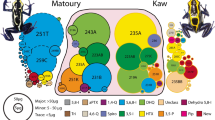Abstract
Gene-encoded peptides with distinct potent bioactivities enable several animals to take advantage of fierce interspecific interaction, as seen in the skin secretion of amphibians. Unlike, most amphibian species that frequently switches terrestrial-aquatic habitats and hides easily from terrestrial predators, tree frogs of small body size are considered as the vulnerable prey in the arboreal habitat. Here, we show the structural and functional diversity of peptide families based on the skin transcriptome of Hyla japonica, which has evolved to be wrapped as an efficient chemical toolkit for defensive use in arboreal habitat. Generally, the presence of antimicrobial peptide and proteinase inhibitor families reveals the functional consistency of Hyla japonica skin compared to other amphibian species. Furthermore, we found that Anntoxin-like neurotoxins with high expression levels are species-specific in tree frogs. Interestingly, derivatives in the Anntoxin-like family exhibit multiple evolutionary traits in modifying the copy number, folding type, and three-dimensional architecture, which are considered essential for targeting the ion channels of terrestrial predators. Together, our study not only reveals the peptide diversity in the skin secretion of H. japonica, but also draws insights into the predator-deterring strategy for coping with arboreal habitat.




Similar content being viewed by others
References
Bailey TL, Williams N, Misleh C, Li WW (2006) MEME: discovering and analyzing DNA and protein sequence motifs. Nucleic Acids Res 34:W369-373
Bevins CL, Zasloff M (1990) Peptides from frog skin. Annu Rev Biochem 59:395–414
Daly JW, Myers CW (1967) Toxicity of Panamanian poison frogs (Dendrobates): some biological and chemical aspects. Science (NY) 156:970–973
Dubin G (2005) Proteinaceous cysteine protease inhibitors. Cell Mol Life Sci: CMLS 62:653–669
Edgar RC (2004) MUSCLE: multiple sequence alignment with high accuracy and high throughput. Nucleic Acids Res 32:1792–1797
Guo X, Li B, Liang S, Lai R, Liu H (2020) A novel Kunitz-type neurotoxin peptide identified from skin secretions of the frog Amolops loloensis. Biochem Biophys Res Commun 528:99–104
Gutiérrez JM et al (2017) Snakebite Envenoming. Nat Rev Dis Primers 3:17063
Hanifin CT (2010) The chemical and evolutionary ecology of tetrodotoxin (TTX) toxicity in terrestrial vertebrates. Mar Drugs 8:577–593
Isbister GK, Bawaskar HS (2014) Scorpion envenomation. N Engl J Med 371:457–463
Kim YH, Brown GB, Mosher FA (1975) Tetrodotoxin: occurrence in atelopid frogs of Costa Rica. Science (NY) 189:151–152
Kim DE, Chivian D, Baker D (2004) Protein structure prediction and analysis using the Robetta server. Nucleic Acids Res 32:W526-531
Kotaki Y, Shimizu Y (1993) 1-Hydroxy-5, 11-dideoxytetrodotoxin, the first N-hydroxy and ring-deoxy derivative of tetrodotoxin found in the newt Taricha granulosa. J Am Chem Soc 115:827–830
Kumar S, Stecher G, Li M, Knyaz C, Tamura K (2018) MEGA X: molecular evolutionary genetics analysis across computing platforms. Mol Biol Evol 35:1547–1549
Liu C et al (2010) Frog skins keep redox homeostasis by antioxidant peptides with rapid radical scavenging ability. Free Radical Biol Med 48:1173–1181
Maan ME, Cummings ME (2012) Poison frog colors are honest signals of toxicity, particularly for bird predators. Am Nat 179:E1-14
Miyazawa K, Noguchi T (2001) Distribution and origin of tetrodotoxin. J Toxicol: Toxin Rev 20:11–33
Noguchi T, Arakawa O (2008) Tetrodotoxin—distribution and accumulation in aquatic organisms, and cases of human intoxication. Mar Drugs 6:220–242
Ombati R, Luo L, Yang S, Lai R (2018) Centipede envenomation: clinical importance and the underlying molecular mechanisms. Toxicon: off J Int Soc Toxinol 154:60–68
Park CB, Kim MS, Kim SC (1996) A novel antimicrobial peptide from Bufo bufo gargarizans. Biochem Biophys Res Commun 218:408–413
Qian ZJ, Jung WK, Kim SK (2008) Free radical scavenging activity of a novel antioxidative peptide purified from hydrolysate of bullfrog skin, Rana Catesbeiana Shaw. Bioresour Technol 99:1690–1698
Rong M et al (2019) The defensive system of tree frog skin identified by peptidomics and RNA sequencing analysis. Amino Acids 51:345–353
Schroeder A et al (2006) The RIN: an RNA integrity number for assigning integrity values to RNA measurements. BMC Mol Biol 7:3
Wang C, Bradley P, Baker D (2007) Protein-protein docking with backbone flexibility. J Mol Biol 373:503–519
Xu X, Lai R (2015) The chemistry and biological activities of peptides from amphibian skin secretions. Chem Rev 115:1760–1846
Yang H et al (2009) Antioxidant peptidomics reveals novel skin antioxidant system. Mol Cell Proteom: MCP 8:571–583
Yasumoto T, Yotsu-Yamashita M (1996) Chemical and etiological studies on tetrodotoxin and its analogs. J Toxicol: Toxin Rev 15:81–90
Yotsu-Yamashita M, Mebs D, Yasumoto T (1992) Tetrodotoxin and its analogues in extracts from the toad Atelopus oxyrhynchus (family: Bufonidae). Toxicon: off J Int Soc Toxinol 30:1489–1492
You D et al (2009) The first gene-encoded amphibian neurotoxin. J Biol Chem 284:22079–22086
Acknowledgements
This work was supported by grants from the National Science Foundation of China (32022010 and 31770835) and National Forestry and Grassland Administration (2020132610) to S.Y. and from the National Science Foundation of China (3200030062) and the Fundamental Research Funds for the Central Universities (2572020BE04) to Y.W. This work was also supported by funding from the Fundamental Research Funds for the Central Universities (2572019BE02) to L.C.
Author information
Authors and Affiliations
Contributions
LC, CY, PMK and XL conducted the majority of experiments including transcriptome sequencing, sequence analysis, structural construction and quantitative real-time PCR. LC, SY, DZ, LL and YW analyzed data. SY, PMK and YW prepared the manuscript. YW and DZ conceived and supervised the project.
Corresponding authors
Ethics declarations
Conflict of interest
The authors declare no competing interests.
Ethical approval
All applicable international, national, and/or institutional guidelines for the care and use of animals were followed.
Informed consent
Informed consent was obtained from all individual participants included in the study.
Additional information
Handling editor: J. G. López.
Publisher's Note
Springer Nature remains neutral with regard to jurisdictional claims in published maps and institutional affiliations.
Supplementary Information
Below is the link to the electronic supplementary material.
Rights and permissions
About this article
Cite this article
Chai, L., Yin, C., Kamau, P.M. et al. Toward an understanding of tree frog (Hyla japonica) for predator deterrence. Amino Acids 53, 1405–1413 (2021). https://doi.org/10.1007/s00726-021-03037-0
Received:
Accepted:
Published:
Issue Date:
DOI: https://doi.org/10.1007/s00726-021-03037-0




